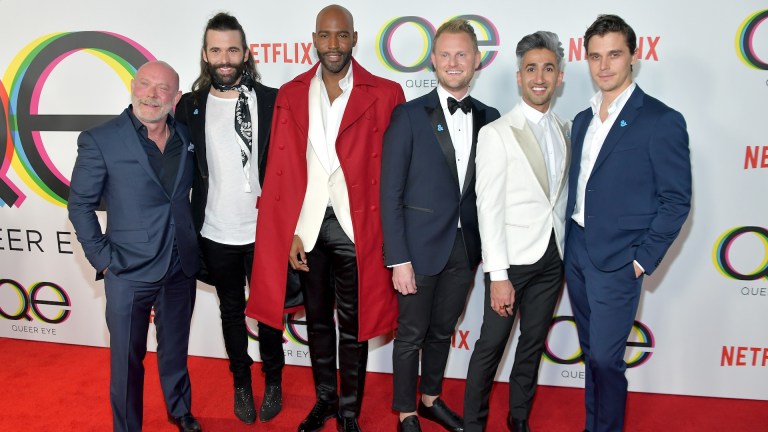Queer Eye Creator on Concluding a TV Institution in the Nation’s Capital
Exclusive: After two decades of transformations, Queer Eye co-creator David Collins discusses the Fab Five’s final journey to Washington, D.C.

While combing through the Merriam-Webster Dictionary in the ‘90s, Queer Eye co-creator and executive producer David Collins stopped on one word that would ignite a decades-long franchise and redefine what reality TV could look like.
“[The dictionary] said, ‘Queer: a unique perspective, a different point of view,’ and that’s really been the heart of [Queer Eye],’” Collins says. “A unique perspective of each of our stories and each of the individual humanity we share with each other.”
Queer Eye is a reality show where five LGBTQ+ experts, known as the Fab Five, help individuals improve their lives through transformations in fashion, grooming, home design, culture, and food. Now, after two decades of makeovers, lifestyle transformations, and tear-filled moments, the show is coming to an end. Netflix announced that the Emmy-winning series will say farewell following the premiere of its 10th season. Before Scout Productions parts ways with the beloved feel-good reality show, the Fab Five head to Washington, D.C.; a politically contentious setting Collins says was “very much an intentional choice.”
In 2003, when Queer Eye for the Straight Guy premiered on Bravo, a title later shortened to simply Queer Eye because it was too long for TV guides, there was not much queer representation in mainstream pop culture. Most prominent examples were often reduced to stereotypes in shows like Will & Grace and Sex and the City. Queer Eye pushed boundaries by centering the show around five openly gay men in a primetime TV program, but still, audiences knew little about the personal lives of original cast members Carson Kressley, Ted Allen, Kyan Douglas, Thom Filicia, and Jai Rodriguez.
“[The original Fab Five] swooped in, they saved the day, and they swooped out. America didn’t really want to know about their lives,” Collins says. “That’s the main change that happened when we brought [the current Fab Five] to the table. We wanted real life, modern day gay men. Their ability to be much more authentic is what really drove the evolution of this series for Netflix.”
When Netflix revived Queer Eye in 2018, it introduced a new Fab Five: Jonathan Van Ness, Antoni Porowski, Karamo Brown, Tan France, and Bobby Berk; later joined by Jeremiah Brent following Berk’s departure in season 8. Together, they’ve built a reputation for fearless authenticity and compassion, making them the perfect team to tackle the nation’s capital in 2025.
Filming season 10 wasn’t the Fab Five’s first time in D.C. During the summer of 2024, both former and current Queer Eye cast members were invited inside the White House by Vice President Kamala Harris amidst her campaign trail to discuss LGBTQ+ progress in the U.S. Collins considers this experience one of the most “monumental visits” of his life.
“There was this enthusiasm and zeal for what was coming next,” Collins says. “Come November, that hope got dashed. So we went to Netflix and said, ‘Let’s go to the source, baby. Let’s show up and knock on the White House door.”
This time around, when the Fab Five traveled to the White House again they weren’t invited in. Instead, they stood outside the large gate with fellow tourists, sparking interesting conversations with both fans and critics. Collins noted the powerful imagery of the crew standing tall outside of the White House next to people protesting for various causes.
Aside from groaning at the summer heat, the Fab Five worked with heroes from across the District, Maryland, and Virginia. Some subjects to look forward to include one of D.C.’s best tour guides, two sisters living together, a preacher, and a man who lives on a boat. Another interesting bit of information Collins provided ahead of the show’s premiere date was that season 10 will only be five episodes long.
Naturally, when people think of D.C., they associate it with the political atmosphere of its institutions; however, Collins says he wasn’t necessarily interested in making a “political statement.” Instead, Collins was focused on highlighting the area’s cultural and socioeconomic diversity.
“The idea of handing the microphone to marginalized communities is a huge part of the heart of Scout Productions,” Collins says. “[Co-creator and executive producer Michael Williams] and I have dedicated the past 27 years to making sure that this story continues to be told, and that each of these guys has an opportunity to bring real transformation to the heroes’ lives.”
One hero Collins still checks in with now and again is Tammye Hicks, known to fans as “Mama Tammye” from season 2. That season, the Fab Five traveled to Georgia, where they helped Mama Tammye open a community center and reconnect with her son, Myles, who had drifted away from the church because of his sexuality. Collins says she was one of his favorite people the show has encountered, and he felt honored to bring her story to the forefront. Though the themes of sexuality and organized religion were sensitive and sometimes difficult to navigate, he’s proud that the episode sparked important conversations and helped reunite a family.
Though Netflix is parting ways with Queer Eye, Collins and Scout Productions aren’t ready to say goodbye to the franchise entirely. Rather than dwell on the show’s ending, Collins is focused on its future, envisioning ways to reimagine the series with even more diverse queer talent at the center.
“We’re proud of all the recognition from the Television Academy, from our peers, from the other peers in the industry, and we’re proud to have won ‘Best Structured Reality Show’ nine years in a row,” Collins says. “Ultimately, we want the legacy of this to live on as a conversation that needed to happen, and by the way, [it needs to happen] even more so now.”
